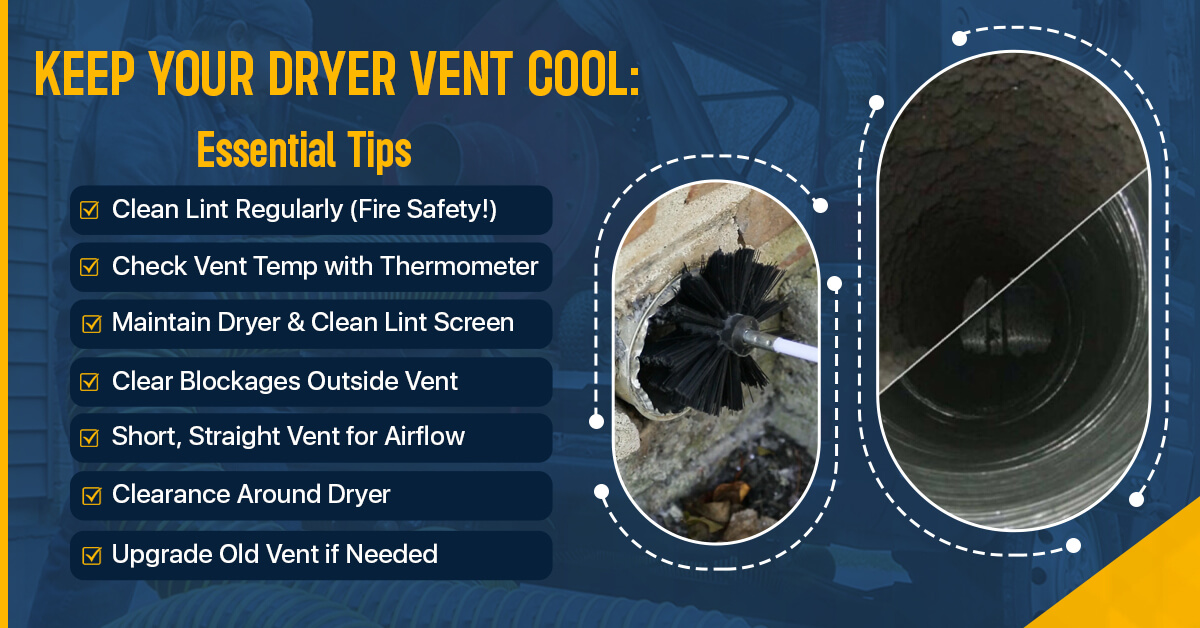
A dryer vent normally gets warm after performing laundry work, but there is a limit to how hot it can get. Understanding the vent’s temperature can keep your laundry room safe while drying your clothes efficiently.
The ideal temperature for your dryer vent is between 120℉ and 160℉ or 49℃ and 71℃. The maximum temperature should never exceed 160℉ (71℃).
Since you will be using the dryer regularly, you must know what it is and how it works, the factors behind the high temperatures, and effective ways to reduce potential heating risks.
A dryer vent is a metallic or flexible tube that connects a dryer to the outside, allowing the moisture and heat from your dryer to leave. It usually passes by the roof or the wall of your laundry room.
When operating, it blows hot air through the drum, drying clothes in the dryer by removing moisture, which creates damp, warm air that goes outside through the vent. You can identify a malfunctioning dryer vent when you notice dampness or mold in the laundry room or spaces around it.
Dryer vents also prevent lint buildup, which if stuck in the vent, can block its airflow, making it less efficient. Also, lint catches fire easily, so knowing your dryer vent is crucial.
Is your dryer vent too hot to the touch? There’s your signal. Check for lint buildup and try to find out if your dryer is:

Various factors affect a dryer vent’s temperature. It is typically the dryer type and the venting mechanism. When a dryer dries your laundry, its inside can reach up to 150℉ (66°C), but it cools down when the hot air goes out.

Likewise, the vent’s temperature rises while performing its task. However, if it crosses 160°F (71°C), there might be a problem. Take a look at the factors responsible for the heat.
The maintenance tip is timeless. The best way to ensure your dryer vent doesn’t exceed temperature limits is to keep the dryer and vent clean. It prevents lint buildup and airflow blockage to keep it cool and risk-free.
Although a dryer vent is designed to endure heat, extreme temperatures are bad news and need your attention and care. What happens if your dryer vent gets too hot?
If the vent has lint and heats a lot, it can catch fire because lint is highly flammable. Clean the vent.
Excessive heat can heat the clothes beyond normal, which can melt the fabrics or damage them in other ways. Ensure optimal airflow.
A hot vent can make the laundry room hot and uncomfortable, with the effects eventually spreading to surrounding rooms. Check for proper ventilation.
High vent temperatures can wear out the dryer fast, using more energy. Regular inspections can help you avoid this.
If the dryer is too hot, it isn’t functioning properly and has been using more energy, which can increase your bills. Regular checkups are necessary.
We know you want to avoid problems in the first place. Here are the best ways to ensure your dryer vent avoids excessive heat.

You have done everything possible to prevent the dryer vent from overheating but to no avail. The problem may be something keen eyes and years of experience can identify. Call our experts. We ensure your clothes do not take long to dry, your energy bills aren’t high, and the vent is cool enough so you can rest assured.
Also Read:How to Identify and Prevent Common Dryer Vent Issues